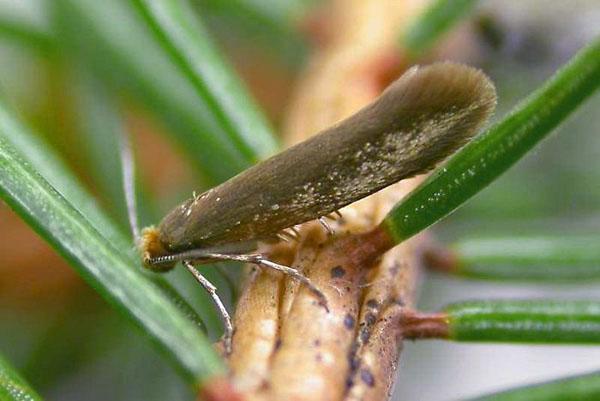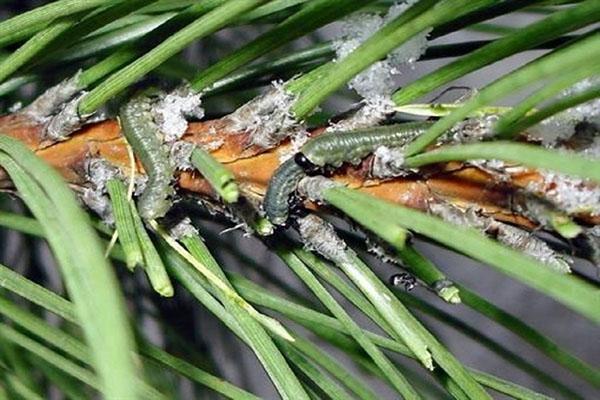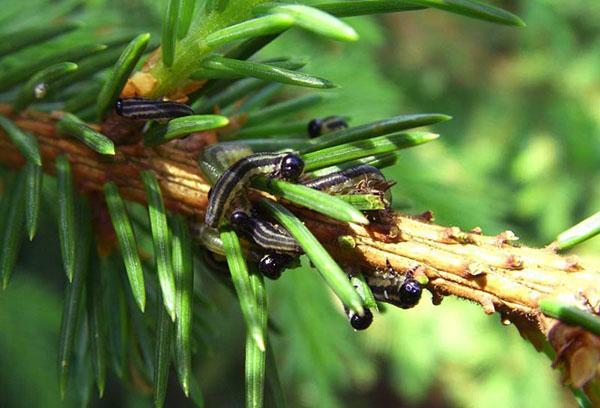Dangerous pests ate: acquaintance and methods of control
 To create a spectacular landscape design, gardeners successfully use conifers... Unfortunately, various spruce pests destroy this lush beauty. As a result of the invasion of "invisible" insects, the external attractiveness of trees is lost. And sometimes it even leads to their death.
To create a spectacular landscape design, gardeners successfully use conifers... Unfortunately, various spruce pests destroy this lush beauty. As a result of the invasion of "invisible" insects, the external attractiveness of trees is lost. And sometimes it even leads to their death.
Conifers are used for framing garden alleys, hedges, green background for alpine slides.
Spruce pests: external features, signs of appearance

To begin with, it is important to become more familiar with the parasites in order to be the first to strike the fatal blow. In nature, there are 3 main types of spruce pests:
- sucking;
- pine needles;
- stem.
Each of them has its own distinctive features, which are important to know well. This will help to identify pests as early as possible and begin to eliminate them.
"Small and remote" sucking parasites
 When a war breaks out, each side chooses its own fighting strategy in order to ultimately defeat the enemy. Likewise, for centuries, people have been openly fighting insects that harm green spaces. At the same time, the parasites skillfully disguise themselves, hoping to win at least one battle. Are they successful in this? Not always.
When a war breaks out, each side chooses its own fighting strategy in order to ultimately defeat the enemy. Likewise, for centuries, people have been openly fighting insects that harm green spaces. At the same time, the parasites skillfully disguise themselves, hoping to win at least one battle. Are they successful in this? Not always.
Sucking parasites that infect spruce include:
- aphid;
- spider mites;
- coccids;
- Hermes.
Most often, they attack the plant not one by one, but in whole colonies. This often happens unnoticed. First, they settle among the greenery, and then suck life-giving juices from the main parts of the plant:
- trunk;
- needles;
- young shoots;
- secular branches;
- root system.
And if it is practically invisible from the side of insects, their presence is determined by sticky feces that appear on the needles.
Sometimes the result of the activity of pests is unnatural formations (galls) that resemble miniature cones.
Aphid
 The appearance of yellowish spots on the spruce indicates the defeat of the tree by aphid colonies. An adult insect only grows up to 2 mm, so a simple test should be done to make sure it is present. A clean sheet of paper is placed under the affected branch. After light tapping, insects fall to its surface.
The appearance of yellowish spots on the spruce indicates the defeat of the tree by aphid colonies. An adult insect only grows up to 2 mm, so a simple test should be done to make sure it is present. A clean sheet of paper is placed under the affected branch. After light tapping, insects fall to its surface.  Treating the tree with soapy water helps to get rid of the pest. In this case, it is necessary to cover the roots of the plant so that chemicals do not get there.
Treating the tree with soapy water helps to get rid of the pest. In this case, it is necessary to cover the roots of the plant so that chemicals do not get there.
Since aphids are bred by red ants, you should control their appearance in the garden or directly on the tree.
Needle-eater
 The formation of a cobweb on the tree indicates damage to the tree by the needle-eater. Its larvae, figuratively speaking, mine the base of the needles. Therefore, with a strong gust of wind, they easily come off, exposing the shoot. The pest can be detected only by direct touching the affected plant branches.
The formation of a cobweb on the tree indicates damage to the tree by the needle-eater. Its larvae, figuratively speaking, mine the base of the needles. Therefore, with a strong gust of wind, they easily come off, exposing the shoot. The pest can be detected only by direct touching the affected plant branches.
Spider mite
 If young seedlings of coniferous trees do not receive proper care, they are affected by spider mites.As a result, the needles are covered with yellow spots, which turn brown and crumble over time. The parasite is especially harmful to plants growing in arid regions of the country. Therefore, it is important to know well how to deal with spider mites on spruce in order to prolong the life of the tree.
If young seedlings of coniferous trees do not receive proper care, they are affected by spider mites.As a result, the needles are covered with yellow spots, which turn brown and crumble over time. The parasite is especially harmful to plants growing in arid regions of the country. Therefore, it is important to know well how to deal with spider mites on spruce in order to prolong the life of the tree.
 The tick has an oval shape, 4 pairs of legs and a gray-green color. The maximum size of an animal is 0.4 mm. The larva matures in about 15-20 days. The female produces up to 5 generations per season. Eggs survive the winter wonderfully on old shoots of the plant.
The tick has an oval shape, 4 pairs of legs and a gray-green color. The maximum size of an animal is 0.4 mm. The larva matures in about 15-20 days. The female produces up to 5 generations per season. Eggs survive the winter wonderfully on old shoots of the plant.
Despite the active viability of the pest, it is easy to eliminate it with the help of chemicals: Fitoverm, Agravertin, Neoron.
These substances kill adults, larvae and eggs on the spot.
False shield
 The main signs of the appearance of a spruce false shield are manifested in a change in the color of the needles. First, shiny traces form on them, then they turn brown and, in the end, fall off. The female pest and her offspring feed on the sap of needles and young shoots, leaving behind honeydew honey. It attracts various insects to the plant, which is one of the signs of a spruce infestation with a false shield.
The main signs of the appearance of a spruce false shield are manifested in a change in the color of the needles. First, shiny traces form on them, then they turn brown and, in the end, fall off. The female pest and her offspring feed on the sap of needles and young shoots, leaving behind honeydew honey. It attracts various insects to the plant, which is one of the signs of a spruce infestation with a false shield.
 Outwardly, the parasite does not look like an insect, since it has a swollen body without limbs. The female attaches herself to the shoot with her proboscis and spends her entire life there. It has a brown color and a smooth shiny surface. Body length - 8 mm, width - 7.5 mm.
Outwardly, the parasite does not look like an insect, since it has a swollen body without limbs. The female attaches herself to the shoot with her proboscis and spends her entire life there. It has a brown color and a smooth shiny surface. Body length - 8 mm, width - 7.5 mm.
Attention - needle-gnawing parasites

Particular attention should be paid to pests that feed on needles and ate buds. Biologists have grouped them into 3 main groups:
- beetles;
- butterflies;
- sawflies.
The presence of the enemy can be identified by the appearance of the needles. If it changes its color to a red-brown color and does not crumble for a long time, it means that a spruce sawfly has settled there. He makes a nest of cobwebs and his own excrement and feeds on needles. His close "friend" is the bud sawfly. It destroys the spruce buds from the inside. And outside the weevils are gnawing.
 From late spring to mid-summer, butterflies circle around the fir trees. They lay eggs, and over time, worms or fat caterpillars of the spotted bat appear on the tree. Insects actively feed on needles, which leads to plant disease. Special chemicals help to neutralize the "enemy".
From late spring to mid-summer, butterflies circle around the fir trees. They lay eggs, and over time, worms or fat caterpillars of the spotted bat appear on the tree. Insects actively feed on needles, which leads to plant disease. Special chemicals help to neutralize the "enemy".
To get rid of caterpillars permanently, it is advisable to treat the spruce with insecticides several times.
Disguised "scouts"
 In addition to external enemies of coniferous trees, there are spruce stem pests. They invade the bark of young seedlings, destroying the tree from the inside. The bark beetle-topographer settles in the trunk of a coniferous tree. It releases a scent that attracts insects within a radius of 11 km. This is the main symptom of a pest.
In addition to external enemies of coniferous trees, there are spruce stem pests. They invade the bark of young seedlings, destroying the tree from the inside. The bark beetle-topographer settles in the trunk of a coniferous tree. It releases a scent that attracts insects within a radius of 11 km. This is the main symptom of a pest.  The defeat of the plant is manifested in a slowed down growth of shoots and a massive fall of old needles. Dried branches usually remain on the tree, as a result, it loses its decorative effect.
The defeat of the plant is manifested in a slowed down growth of shoots and a massive fall of old needles. Dried branches usually remain on the tree, as a result, it loses its decorative effect.
It is necessary to destroy the beetle before the offspring are born.
 Dangerous stem pests of spruce trees are large bark beetles, black longhorn beetles, making many moves inside the wood. As a result, the development of the plant is disrupted, and it becomes sick.
Dangerous stem pests of spruce trees are large bark beetles, black longhorn beetles, making many moves inside the wood. As a result, the development of the plant is disrupted, and it becomes sick.
Artillery strike on the cones
 A special decoration of coniferous trees is exotic fruits. And, of course, insects do not bypass them. A unique butterfly is considered to be a particularly dangerous pest of spruce cones. With the onset of summer, she lays eggs between the scales of young cones. Over time, caterpillars appear there, which destroy the fruit. As a result, the husk falls out of it, the shape is distorted and the color changes.
A special decoration of coniferous trees is exotic fruits. And, of course, insects do not bypass them. A unique butterfly is considered to be a particularly dangerous pest of spruce cones. With the onset of summer, she lays eggs between the scales of young cones. Over time, caterpillars appear there, which destroy the fruit. As a result, the husk falls out of it, the shape is distorted and the color changes.
 Often, the pineal moth does not act alone. Caterpillars of the spruce leafworm, moth, seed eaters and gall midges are considered no less dangerous. If you do not fight them, by the fall there will not be a single healthy cone on the tree. This means that the spruce will lose its attractiveness.
Often, the pineal moth does not act alone. Caterpillars of the spruce leafworm, moth, seed eaters and gall midges are considered no less dangerous. If you do not fight them, by the fall there will not be a single healthy cone on the tree. This means that the spruce will lose its attractiveness.